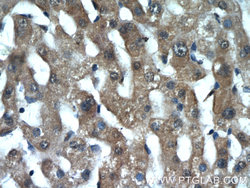Antibody data
- Antibody Data
- Antigen structure
- References [12]
- Comments [0]
- Validations
- Western blot [1]
- Immunohistochemistry [1]
Submit
Validation data
Reference
Comment
Report error
- Product number
- 24766-1-AP - Provider product page

- Provider
- Proteintech Group
- Product name
- INSIG2 antibody
- Antibody type
- Polyclonal
- Description
- KD/KO validated INSIG2 antibody (Cat. #24766-1-AP) is a rabbit polyclonal antibody that shows reactivity with human, mouse, rat and has been validated for the following applications: IF, IHC, IP, WB,ELISA.
- Reactivity
- Human, Mouse, Rat
- Host
- Rabbit
- Conjugate
- Unconjugated
- Isotype
- IgG
- Vial size
- 20ul, 150ul
Submitted references Excessive SOX8 reprograms energy and iron metabolism to prime hepatocellular carcinoma for ferroptosis.
Insulin-induced gene 2 protects against hepatic ischemia-reperfusion injury via metabolic remodeling.
A Multi-Level Systems Biology Analysis of Aldrin's Metabolic Effects on Prostate Cancer Cells.
In vivo PAR-CLIP (viP-CLIP) of liver TIAL1 unveils targets regulating cholesterol synthesis and secretion.
Alleviation of Limosilactobacillus reuteri in polycystic ovary syndrome protects against circadian dysrhythmia-induced dyslipidemia via capric acid and GALR1 signaling.
Insulin-induced gene 2 expression is associated with cervical adenocarcinoma malignant behavior.
Dickkopf-1 promotes vascular smooth muscle cell foam cell formation and atherosclerosis development through CYP4A11/SREBP2/ABCA1.
The GR-gp78 Pathway is involved in Hepatic Lipid Accumulation Induced by Overexpression of 11β-HSD1.
AGR2-induced cholesterol synthesis drives lovastatin resistance that is overcome by combination therapy with allicin.
CD36 promotes de novo lipogenesis in hepatocytes through INSIG2-dependent SREBP1 processing.
The gluconeogenic enzyme PCK1 phosphorylates INSIG1/2 for lipogenesis.
p38α/S1P/SREBP2 activation by the SAM-competitive EZH2 inhibitor GSK343 limits its anticancer activity but creates a druggable vulnerability in hepatocellular carcinoma.
Yang X, Gu C, Cai J, Li F, He X, Luo L, Xiao W, Hu B, Hu J, Qian H, Ren S, Zhang L, Zhu X, Yang L, Yang J, Yang Z, Zheng Y, Huang X, Wang Z
Redox biology 2024 Feb;69:103002
Redox biology 2024 Feb;69:103002
Insulin-induced gene 2 protects against hepatic ischemia-reperfusion injury via metabolic remodeling.
Wu Y, Li C, Khan AA, Chen K, Su R, Xu S, Sun Y, Gao F, Wang K, Wang X, Lian Z, Wang S, Yu M, Hu X, Yang F, Zheng S, Qiu N, Liu Z, Xu X
Journal of translational medicine 2023 Oct 19;21(1):739
Journal of translational medicine 2023 Oct 19;21(1):739
A Multi-Level Systems Biology Analysis of Aldrin's Metabolic Effects on Prostate Cancer Cells.
Bedia C, Dalmau N, Nielsen LK, Tauler R, Marín de Mas I
Proteomes 2023 Mar 23;11(2)
Proteomes 2023 Mar 23;11(2)
In vivo PAR-CLIP (viP-CLIP) of liver TIAL1 unveils targets regulating cholesterol synthesis and secretion.
Vatandaslar H, Garzia A, Meyer C, Godbersen S, Brandt LTL, Griesbach E, Chao JA, Tuschl T, Stoffel M
Nature communications 2023 Jun 9;14(1):3386
Nature communications 2023 Jun 9;14(1):3386
Alleviation of Limosilactobacillus reuteri in polycystic ovary syndrome protects against circadian dysrhythmia-induced dyslipidemia via capric acid and GALR1 signaling.
Li S, Zhai J, Chu W, Geng X, Wang D, Jiao L, Lu G, Chan WY, Sun K, Sun Y, Chen ZJ, Du Y
NPJ biofilms and microbiomes 2023 Jul 8;9(1):47
NPJ biofilms and microbiomes 2023 Jul 8;9(1):47
Insulin-induced gene 2 expression is associated with cervical adenocarcinoma malignant behavior.
Qian Y, Li X, Qiu J, Zhang R
Molecular biology reports 2023 Feb;50(2):1553-1563
Molecular biology reports 2023 Feb;50(2):1553-1563
Dickkopf-1 promotes vascular smooth muscle cell foam cell formation and atherosclerosis development through CYP4A11/SREBP2/ABCA1.
Li X, Zheng T, Zhang Y, Zhao Y, Liu F, Dai S, Liu X, Zhang M
FASEB journal : official publication of the Federation of American Societies for Experimental Biology 2023 Aug;37(8):e23048
FASEB journal : official publication of the Federation of American Societies for Experimental Biology 2023 Aug;37(8):e23048
The GR-gp78 Pathway is involved in Hepatic Lipid Accumulation Induced by Overexpression of 11β-HSD1.
Hu M, Han T, Pan Q, Ni D, Gao F, Wang L, Ren H, Zhang X, Jiao H, Wang Y, Dai D, Man Y, Tang W, Sun Y, Li W, Li J, Li G
International journal of biological sciences 2022;18(8):3107-3121
International journal of biological sciences 2022;18(8):3107-3121
AGR2-induced cholesterol synthesis drives lovastatin resistance that is overcome by combination therapy with allicin.
Sheng N, Wang YQ, Wang CF, Jia MQ, Niu HM, Lu QQ, Wang YN, Feng D, Zheng XX, Yuan HQ
Acta pharmacologica Sinica 2022 Nov;43(11):2905-2916
Acta pharmacologica Sinica 2022 Nov;43(11):2905-2916
CD36 promotes de novo lipogenesis in hepatocytes through INSIG2-dependent SREBP1 processing.
Zeng H, Qin H, Liao M, Zheng E, Luo X, Xiao A, Li Y, Chen L, Wei L, Zhao L, Ruan XZ, Yang P, Chen Y
Molecular metabolism 2022 Mar;57:101428
Molecular metabolism 2022 Mar;57:101428
The gluconeogenic enzyme PCK1 phosphorylates INSIG1/2 for lipogenesis.
Xu D, Wang Z, Xia Y, Shao F, Xia W, Wei Y, Li X, Qian X, Lee JH, Du L, Zheng Y, Lv G, Leu JS, Wang H, Xing D, Liang T, Hung MC, Lu Z
Nature 2020 Apr;580(7804):530-535
Nature 2020 Apr;580(7804):530-535
p38α/S1P/SREBP2 activation by the SAM-competitive EZH2 inhibitor GSK343 limits its anticancer activity but creates a druggable vulnerability in hepatocellular carcinoma.
Yang PM, Hong YH, Hsu KC, Liu TP
American journal of cancer research 2019;9(10):2120-2139
American journal of cancer research 2019;9(10):2120-2139
No comments: Submit comment
Supportive validation
- Submitted by
- Proteintech Group (provider)
- Main image

- Experimental details
- rat liver tissue were subjected to SDS PAGE followed by western blot with 24766-1-AP( INSIG2 Antibody) at dilution of 1:1000
- Sample type
- tissue
Supportive validation
- Submitted by
- Proteintech Group (provider)
- Main image

- Experimental details
- The INSIG2 antibody from Proteintech is a rabbit polyclonal antibody to a fusion protein of human INSIG2. This antibody recognizes human, mouse, rat antigen. The INSIG2 antibody has been validated for the following applications: ELISA, WB, IHC analysis.
 Explore
Explore Validate
Validate Learn
Learn Western blot
Western blot ELISA
ELISA